UNDERNOTED ARE THE CORONIAL HEARING TRANSCRIPTS
THE FIRST HEARING WAS HELD ON 2 DECEMBER 1996
AND THEN ADJOURNED TO 13 OCTOBER 1997
AT THE BEGINNING OF THE SECOND HEARING AN ATTEMPT
WAS MADE ON MY LIFE TO SHUT ME UP |
Img054 Transcript - Coronial Hearing, 2nd December 1996, page 22
Constable Samantha Johnson said that John Phillips, the driver of the utility came into the police station to "supply" his statement on 16 January 1994. The accident occurred on 12 January 1994. Constable Samantha Johnson had told me that John Phillips had typed his statement at home.
Referencing Img003 & Img004 in the grassed area of the traffic island to the left with the street sign on it, Constable Samantha Johnson said that there was a broken bicycle pedal, glass, broken bits and pieces everywhere on this grassed area of the traffic island which is on the left hand side of the road
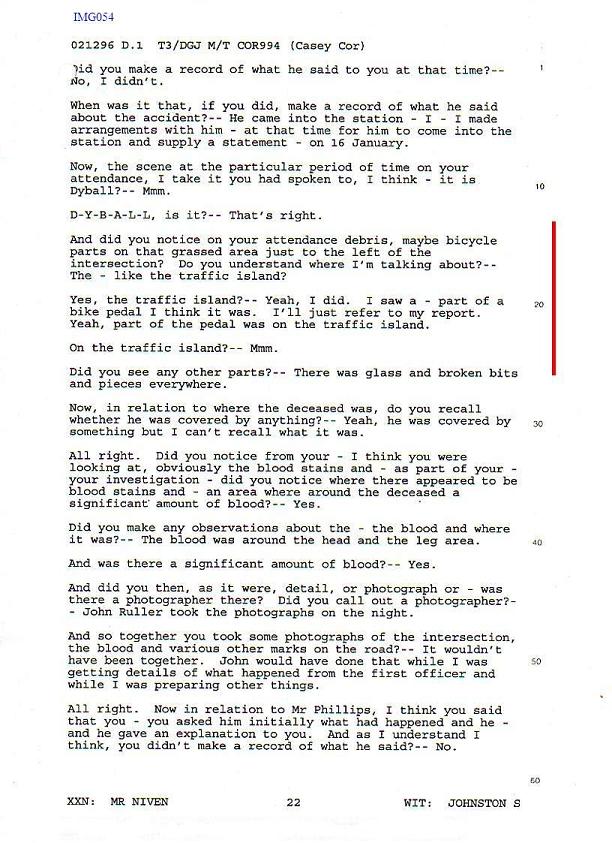
|
Img055 Transcript - 2nd December 1996, page 31
Constable Samantha Johnson makes reference to the debris, glass, bits and pieces of metal, scattered along a whole section of the traffic island with the Pritchard Street sign on it, that is the grassed area of the traffic island (Img003)
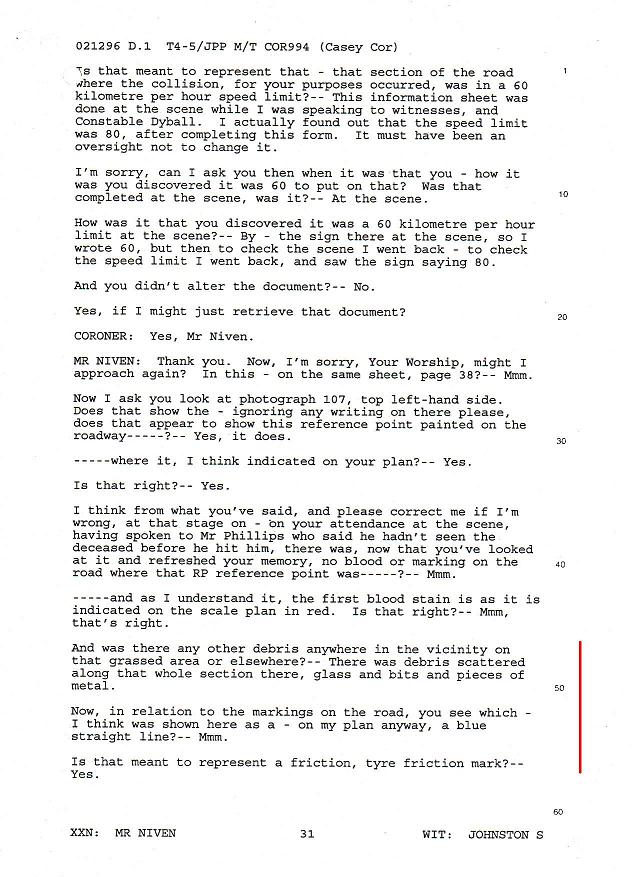
|
Img056 Transcript - 2nd December 1996, page 32
Constable Samantha Johnson makes reference to the debris, glass, bits and pieces of metal, scattered along a whole section of the traffic island with the Pritchard Street sign on it, that is the grassed area of the traffic island (Img003)
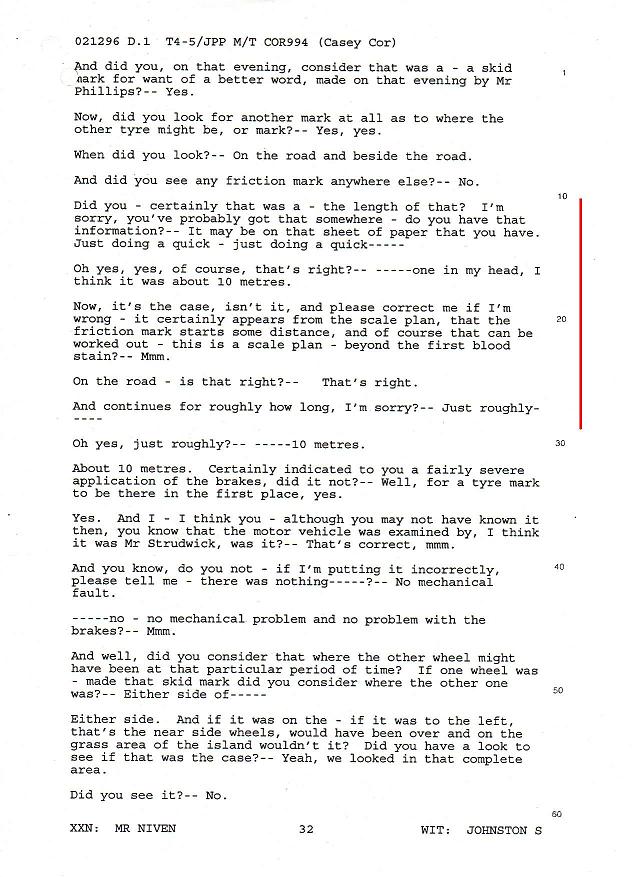
|
Img057 Transcript - 2nd December 1996, page 37
In the police photograph Img005, to the left by the road edge, there is a line of blood that had been covered with dirt, and a spray of blood on the road, indicating that Andrew had been moved at the accident site. The line of blood that was covered with dirt is positioned on the road just prior to the crash helmet. It appears on the face of it, that when Andrew was moved about, that one of the damaged arteries sprayed blood on the road as the heart was pumping. Andrew was placed initially in the position where the line of blood that had been covered with dirt. That position of Andrew did not match up exactly to the "supposed" final resting place after the throw from the centre of the intersection. Andrew was then again shifted and then placed on the road further away from the intersection. The "fresh" blood was then covered with dirt to conceal the evidence that Andrew had been moved about. These forensic areas of interest were not marked off by Constable Samantha Johnson and Sergeant Robert John Ruller with white tickets
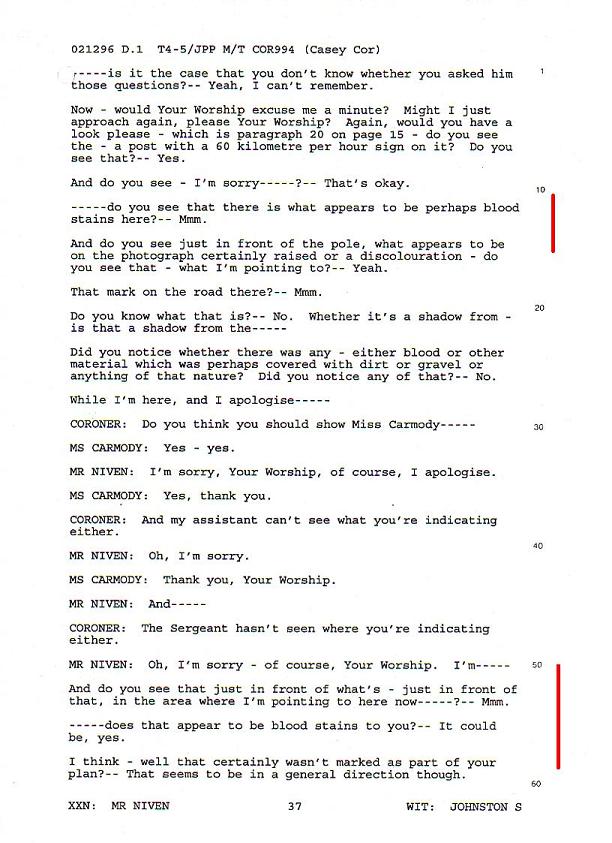
|
Img058 Transcript - 2nd December 1996, page 38
Constable Samantha Johnson did not mark off with white tickets the blood marks that are not in a directional line (Img004 & 005). Reference is made to the scattered debris on the traffic island, including the bicycle pedal. It is confirmed that the vehicle may have mounted the traffic island. The broken bicycle pedal is point 18 on Constable Samantha Johnson’s diagram Img045. The position of the broken bicycle pedal is more clearly seen in the surveyor’s diagram Img047(b). It is marked as point 18 on the surveyor’s diagram
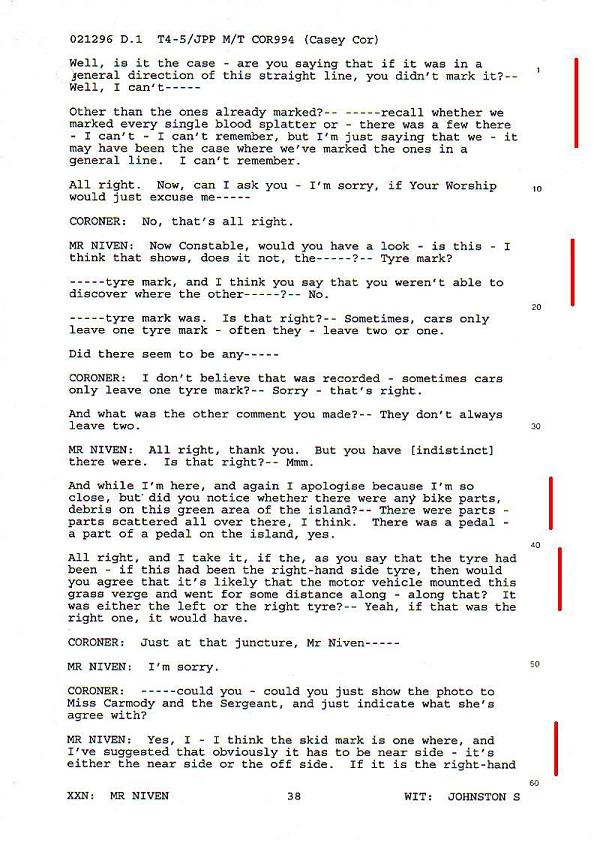
|
Img059 Transcript - 2nd December 1996, page 39
It was stated that the utility’s left wheel would have gone on the grassed area of the traffic island (Img003). The broken bicycle pedal was located on the traffic island. There are two scuff marks on the curb’s edge (Img002). For the scenario of the utility’s left tires traveling on the traffic island, please refer to surveyor’s diagram Img047(a) and Img047(b). Note that the utility’s left front tire would have gone over the location of point 18. Point 18 is where the bicycle pedal was located by Constable Samantha Johnson. The surveyor’s diagrams are accurate
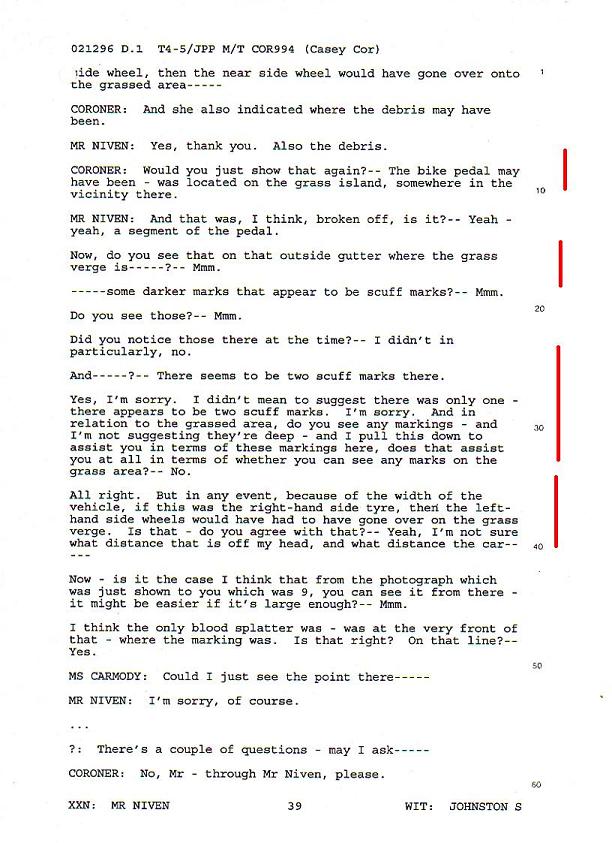
|
Img060 Transcript - 2nd December 1996, page 41
There was no explanation offered by Constable Samantha Johnson to the court as to why she did not plot the details of the accident site on her “To Scale” Diagram. Constable Samantha Johnson did not follow the procedures as set out in the Queensland Police Service Traffic Accident Investigation Law & Procedure Manual page 8.3 (Img147), page 8.4 (Img148) and page 8.5 (Img149). Constable Samantha Johnson then indicates that John Phillips drove "after the accident" to where his vehicle was photographed. Transcript line 59-60

|
Img061 - Transcript - 2nd December, page 44
There was a query raised to Constable Samantha Johnson about the point of impact (collision point). There was a query raised about the gouge mark on the road as seen in police photograph Img002
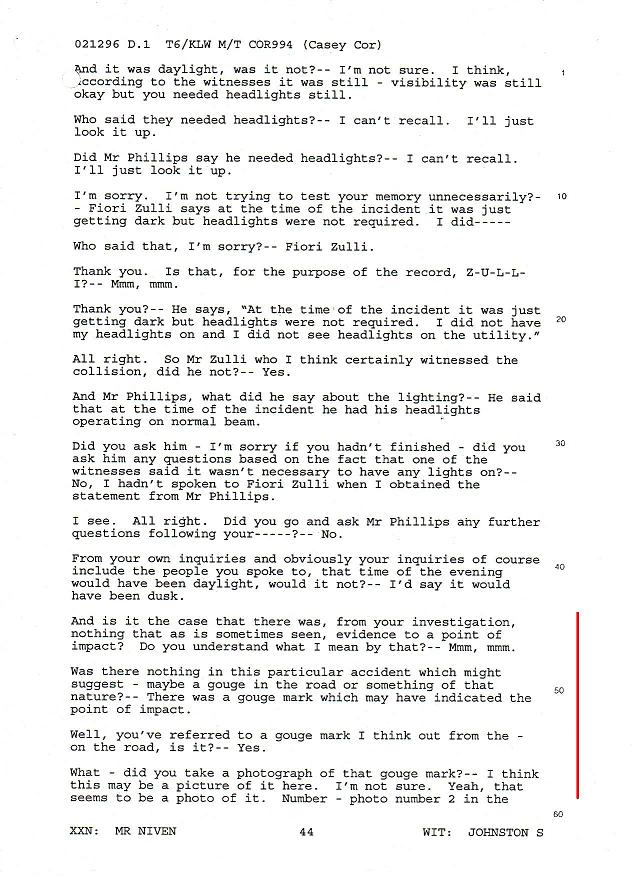
|
Img062 - 2nd December 1996, page 45
Constable Samantha Johnson refers to the gouge mark as a scratch mark on the road surface that does not necessarily tie the mark in with the collision. Counsel asks Constable Samantha Johnson if the cyclist was struck west of the stop sign. The evidence shows that this may have been the case. Constable Samantha Johnson does not answer the question asked. By not answering the question asked Constable Samantha Johnson was concealing evidence by being evasive. It was her job to determine the collision point of the accident and to put that collision point on her diagrams and/or maps of the accident site and to document all the trauma associated with the accident
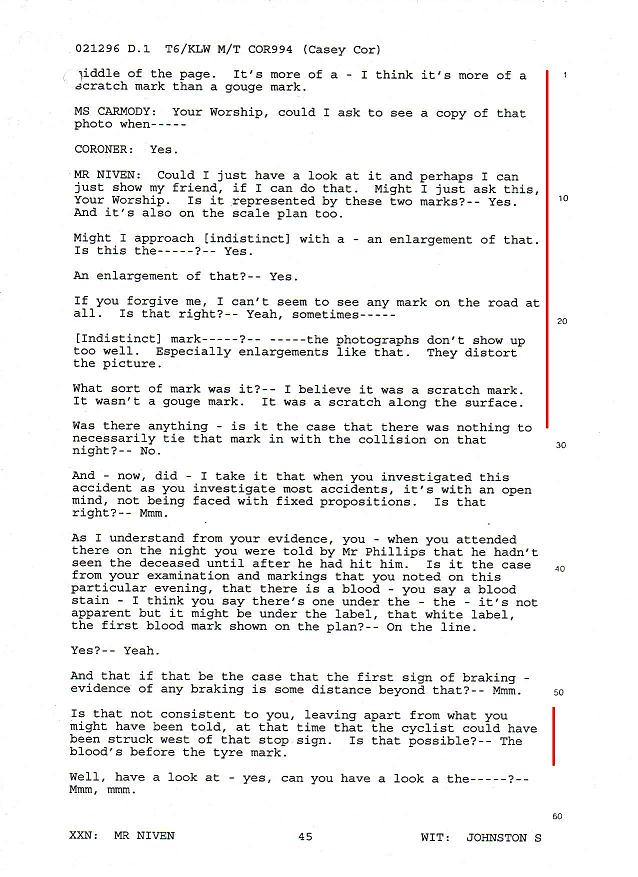
|
Img063 Transcript - 2nd December 1996, pge 46
Counsel was trying to get out of Constable Samantha Johnson the point of impact (collision) given that the blood stain starts some distance from the intersection. Constable Samantha Johnson did not give an answer. This unanswered question is contrary to police procedure in detecting the point of impact – refer to and extract from the Queensland Police Service Traffic Accident Investigation Law & Procedure Manual page 3.15 whereby it is noted that the place of impact can be found by:
(a) gouge marks on the road surface
(b) glass and other objects collected together and
(c) blood areas on certain occasions (Img142)
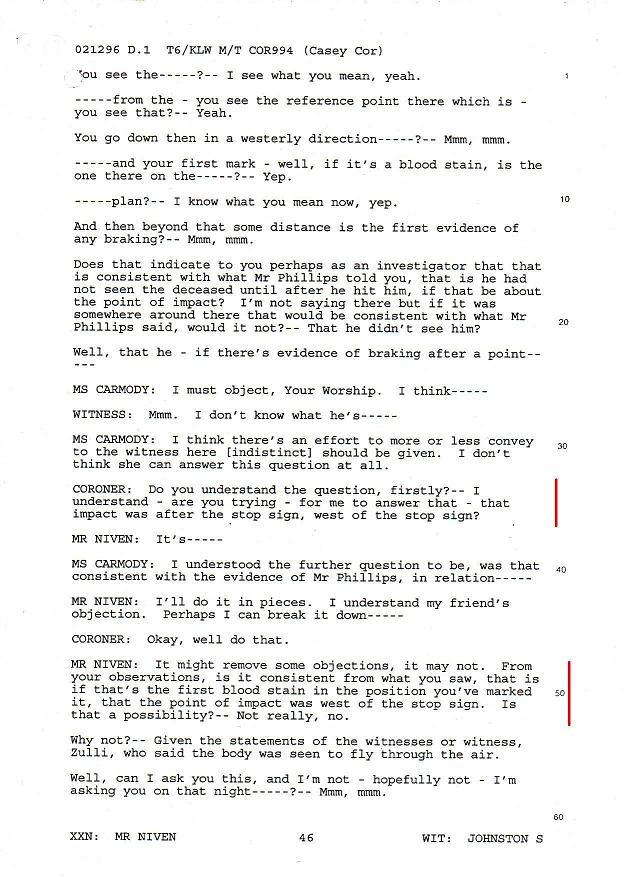
|
Img064 Trasncript - 2nd December 1996, page 47
Counsel tried to get out of Constable Samantha Johnson if the collision point was west of the stop sign. Constable Samantha Johnson was evasive. She did not answer the question. Constable Samantha Johnson concealed evidence as to the collision point of the accident
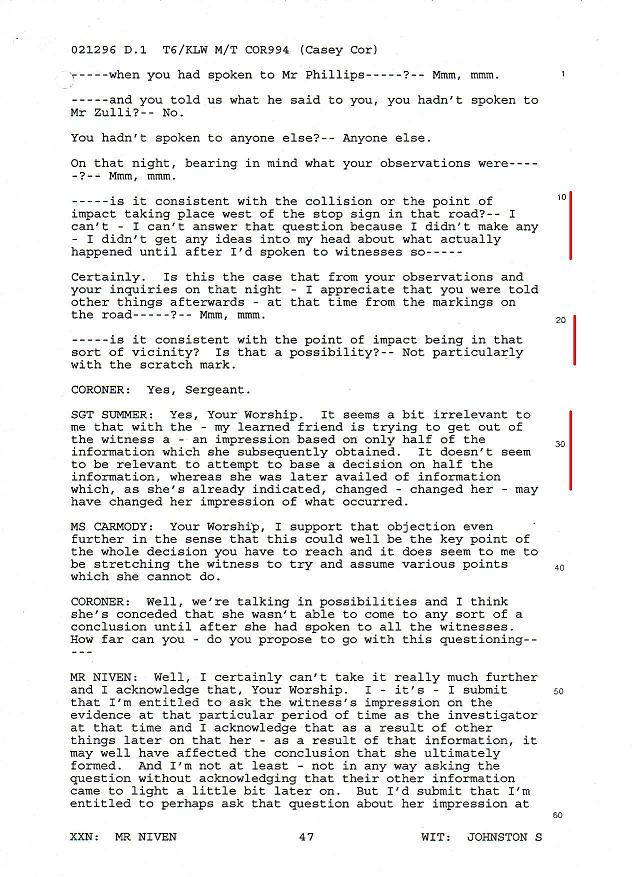
|
Img065 Transcript - 2nd December 1996, page 49
Constable Samantha Johnson said that there were no photographs taken of the debris on the night of the accident. Constable Samantha Johnson confirms that other than the gouge mark in the middle of the intersection, there are no other marks, no other debris, no other blood marks or other marks at the junction of the intersection. According to the Queensland Police Service Traffic Accident Investigation Law & Procedure manual page 8.1, there should have been photographs taken of the debris, photographs taken of all the vehicles at the accident site, photographs taken of all the gouge marks at the accident site (Img033) and a close examination of the bicycle to determine the trauma marks on it. Sergeant Robert John Ruller and Constable Samantha Johnson concealed evidence in that they did not take photographs of the debris of the accident on the grassed area of the traffic island
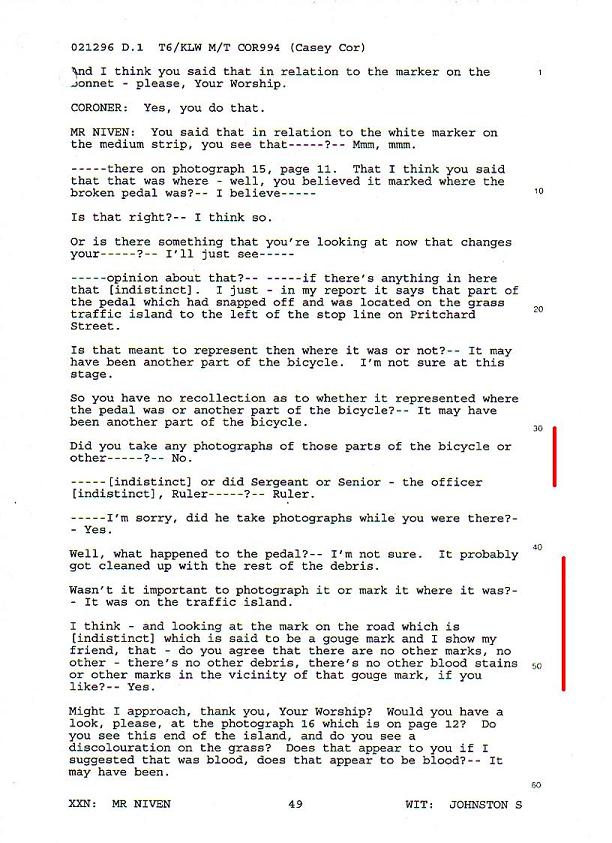
|
Img066 Transcript - 2nd December 1996, page 71
Constable Ben Dyball, Wynnum Police Station, said that he saw most of the bicycle underneath the front of the utility (refer to Img031 and 032). The bicycle had been moved before the police photographs were taken. Constable Ben Dyball said that he saw the utility for the first time parked in the vicinity of the light pole (Img006). This is incorrect. On the night of the accident, Constable Ben Dyball told me that he and others had put Andrew on the grassed area next to the utility. In actual fact, a part of the bicycle was underneath the utility where the brake mark had ended on the road. The utility was then moved at the accident site to where Constable Ben Dyball says that he first saw it
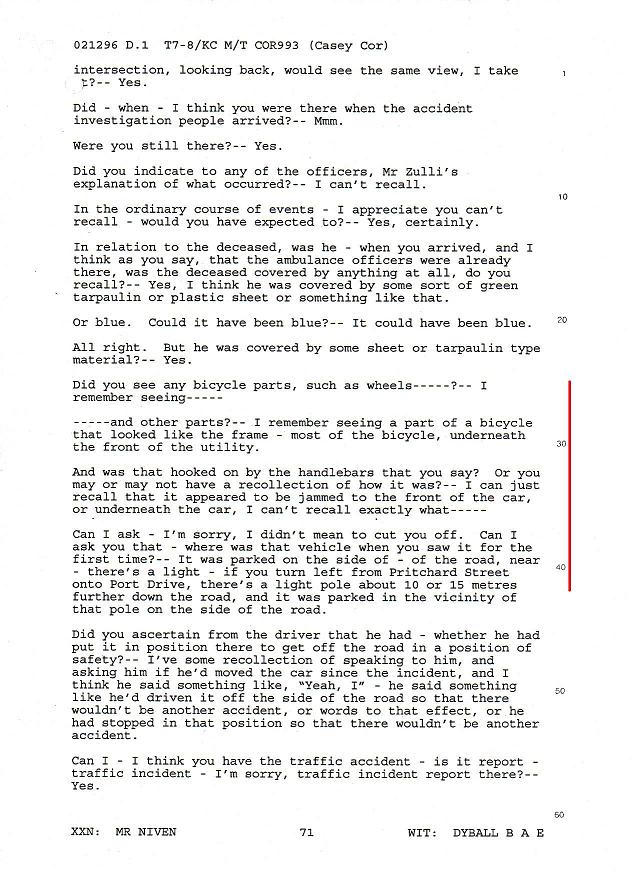
|
Img067 - 13 October 1997, page 142
Please refer to Fiore Zulli’s (and Img108) police statement whereby he stated to Constable Johnson that he did not see the collision. On the night of the accident, Zulli told Constable Ben Dyball that he saw the collision – please refer to "documents" - Img131, 132 and 133). From an objective point of view, if some person saw a cyclist go through the intersection into the path of an oncoming utility, then he would see the collision. Fiore Zulli states that the bicycle was caught under the left wheel of the utility involved in the accident
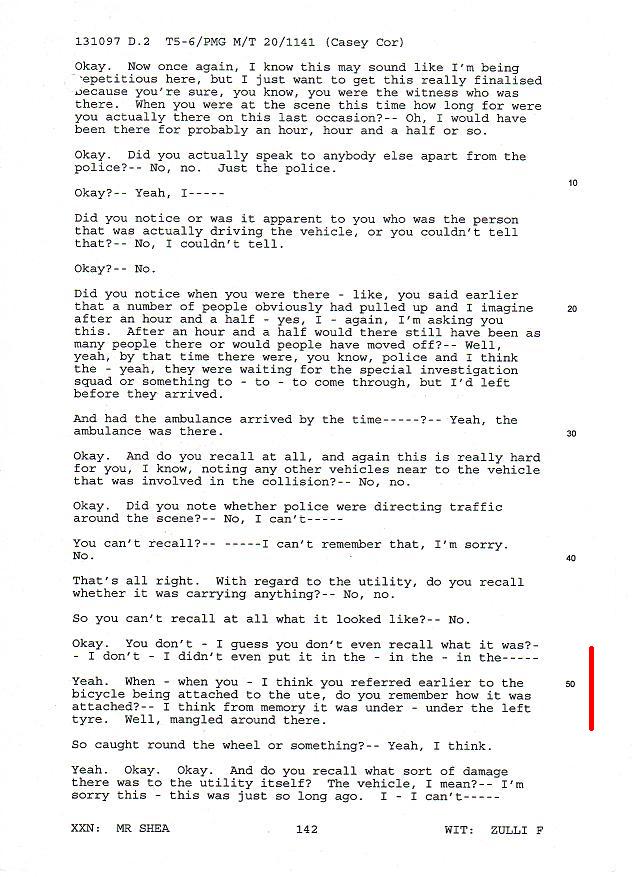
|
Img068 Transcript - 2 December 1996, page 66
Constable Ben Dyball refered to his notebook during the hearing – reference - "documents"- Img131, 132 and 133. Constable Ben Dyball stated that my sister, Margaret Samootin, was at accident site. There was no statement taken by Constable Ben Dyball from John Phillips, the driver of the utility, and Scott Anthony Bryant, who claimed that he was driving the red Ford Falcon CEW045 some 500 meters behind the utility. Odd as it may sound, there were no details taken of the driver of the utility, John Phillips, who it was claimed had “killed” Andrew

|
Img068 Transcript - 2 December 1996, page 67
Continuation of the transcript produced above. Constable Ben Dyball admits not to taking down any details of his conversation in his notebook. Constable Ben Dyball did not take any statement from Scott Anthony Bryant - a witness

|
Img070 Transcript - 13 October 1997, page 173
At the hearing held on 13 October 1997, Constable Ben Dyball inferred that my sister, Margaret Samootin, was not at the accident site, contrary to what he stated at the hearing held on 2 December 1996 (Img171 & 172 below). Constable Ben Dyball stated, at the hearing held on 13 October 1997, that he had picked up my sister at her home and took her to the mortuary. Constable Ben Dyball took 20 minutes to get to the morgue from the accident site (Img140). The time factor did not allow him to make a deviation from the accident site at Lytton to my sister’s home at 51 Peel Street, Manly, and then to the Brisbane morgue at Middle Street, Coopers Plains. Constable Ben Dyball states that he could not recall how he came to know that it was my son who was involved in the accident. It was at this inquest that an attempt was made on my life to shut me up
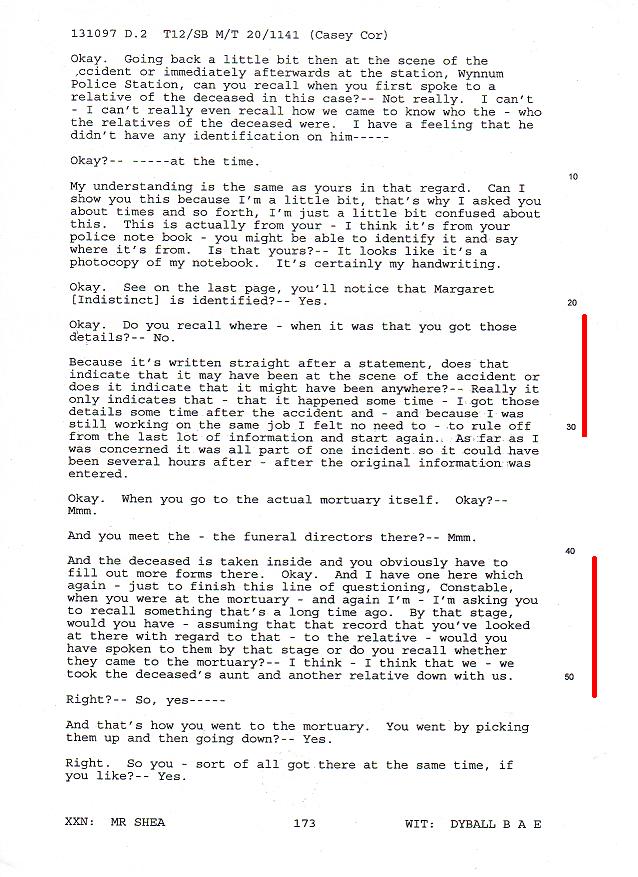
|
Img071 Transcript - 13 October 1997, page 174
Constable Ben Dyball said that “we cleaned up the deceased so the photograph was already taken when we got there”. Img018 shows Andrew at the accident site with blood over his face. The police identification photographs (Img020) shows Andrew with his face “cleaned”. The question to ask is – “Where was Andrew when his face was cleaned and who cleaned his face?”
According to the records Constable Ben Dyball arrived at the morgue at 22.19 hours (10.19pm) (Img140). Andrew was delivered to the morgue at 22.50 hours (10.50pm) (Img119 & Img122). Constable Ben Dyball took the identification photograph of Andrew at 22.50hours (10.50pm) (Img125)
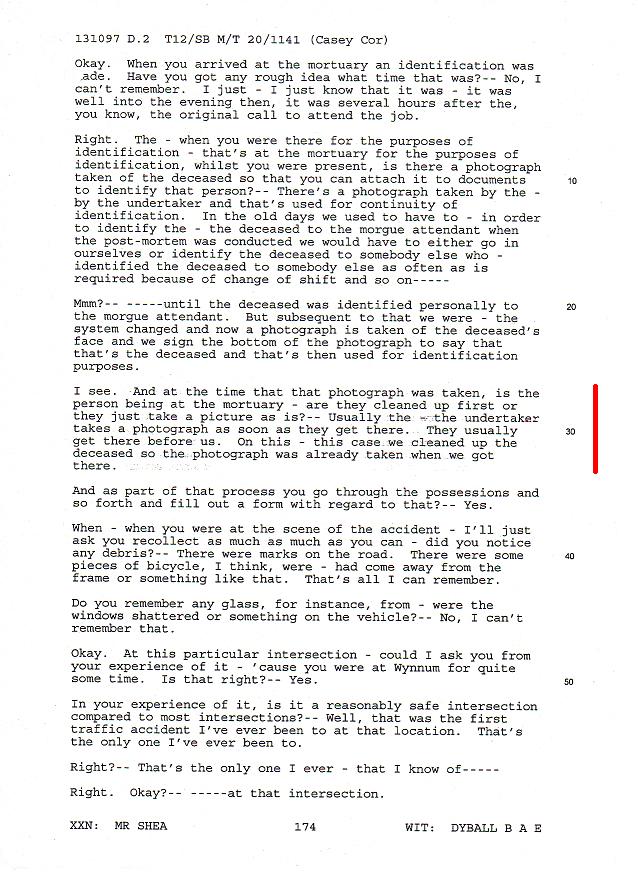
|
Img072 Transcript - 2nd December 1996, page 63
Senior Constable Strudwick stated that the utility involved in the collision was in a good mechanical condition - reference his report (Img109). He said if the road surface was the same for both tires, there should have been two marks on the road; otherwise if there were different surfaces there may be one mark left on the road
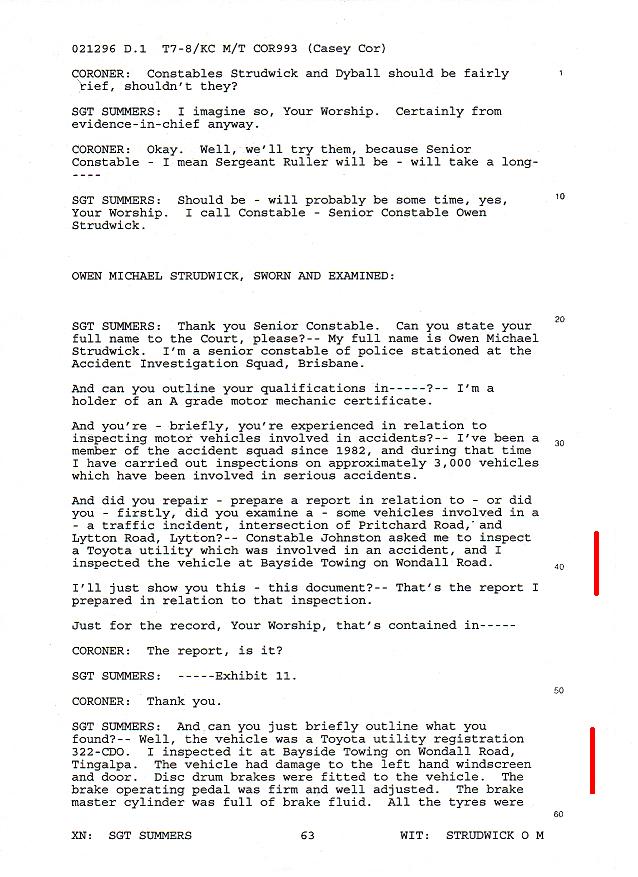
|
Img073 Transcript - 2nd December 1996, page 64
Continuation of the transcript as mentioned previously - page 63 above about the vehicle being in good mechanical condition

|
Img074 Transcript - 2nd December 1996, page 65
Continuation of the transcript mentioned above (page 64). Further discussion about the brake marks left on the road, i.e. reason for one brake mark on the road - different base surfaces
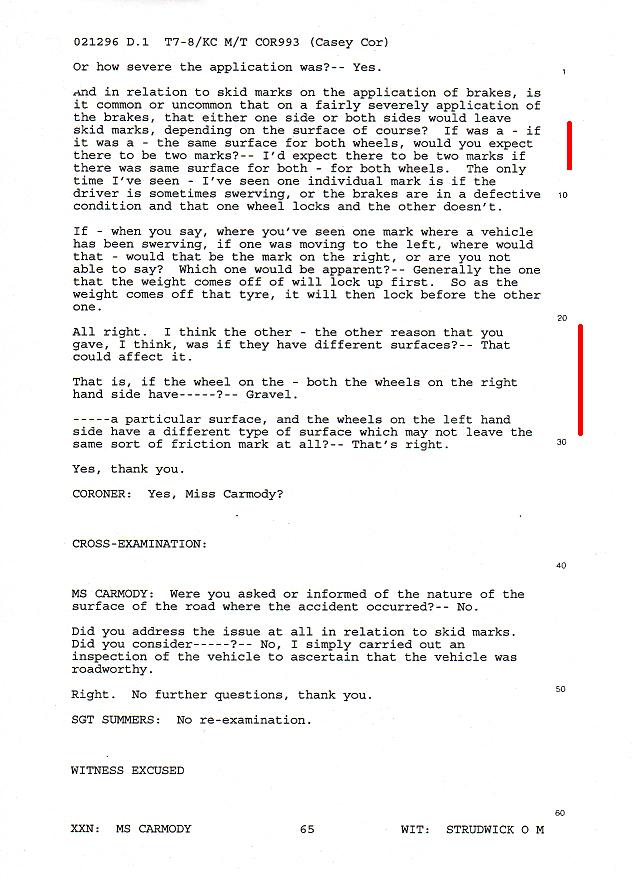
|
Img075 Transcript - 14 October 1997, page 912
Constable Samantha Johnson’s and Sergeant Robert John Ruller’s police note books have disappeared. I made numerous requests for the notebooks. The register of police notebooks issued at the Traffic Accident Investigation Squad has also disappeared. For all his expert experience, Sergeant Robert John Ruller did not take accurate measurements of the accident site. This problem had to be rectified by me by hiring a local surveyor to the area of the accident site to rectify the situation of inaccurate measurements taken. I could not attend the Inquest on this day. I was too sick as I had been "nobbled" the day before just prior to the hearing commencing.
Sergeant John Ruller talks ad lib about the accident as he had no police note book to refer to. For all his credentials, one has to ask the question - "Why Sergeant John Ruller did not take any police notes at the accident site when it was a requirement to do so?"
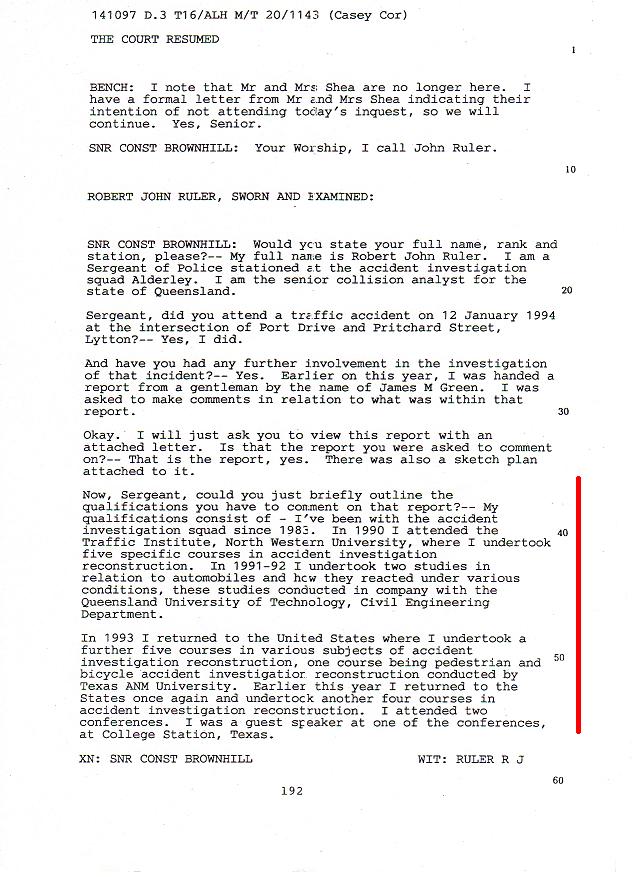
|
Img076 Transcript - 14 October 1997, page 193
Sergeant Ruller dissected a report that was prepared by James M Green, G E Engineering, 120 Kalmia Drive, Ashville, North Carolina, United States. James M Green’s report can be seen as Img091, 092, 093, 094, 095 and 096. James M Green’s former business name was Resource Engineering. James M Green produced a flawed report. James M Green did not look at the length of the skid mark on the road to determine the speed of the utility at the time of braking. James M Green looked at the bicycle’s frame to determine the speed of the vehicle. Forensics show that the speed of the vehicle was 40 to 50 kilometers per hour – reference Img044, 048, 049 & 050.
According to the Queensland Police Service Traffic Accident Investigation Law & Procedure manual page 9.5 Constable Johnson and Sergeant John Ruller should have worked out the speed of the utility at the time of braking by the length of the skid mark on the road. At no time did Sergeant John Ruller look at the evidence that was produced to the Court, i.e. the location of the debris at the accident site, the broken bicycle pedal, etc. During hearings, transcripts can be made readily available within an hour or so. I have worked as a Court transcript typist
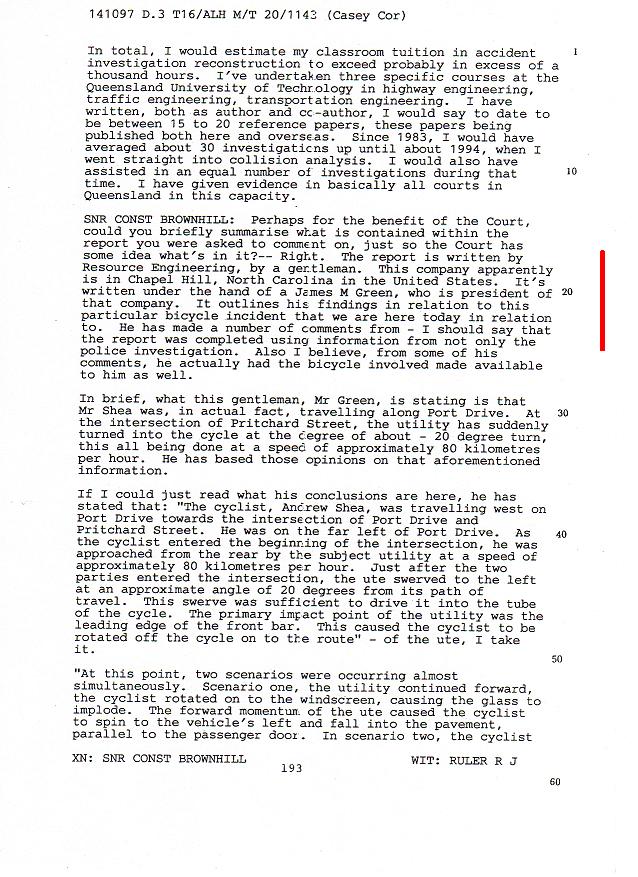
|
Img077 Transcript - 14 October 1997, page 194
Odd as it may be, Sergeant Robert John Ruller, instead of producing an independent accident reconstruction report, prepared a report in response to James M Green's flawed report

|
Img078 Transcript - 14 October 1997, page 195
Still a continiuation of a response to the report prepared by James M Green, i.e. no reconstruction of Andrew's accident
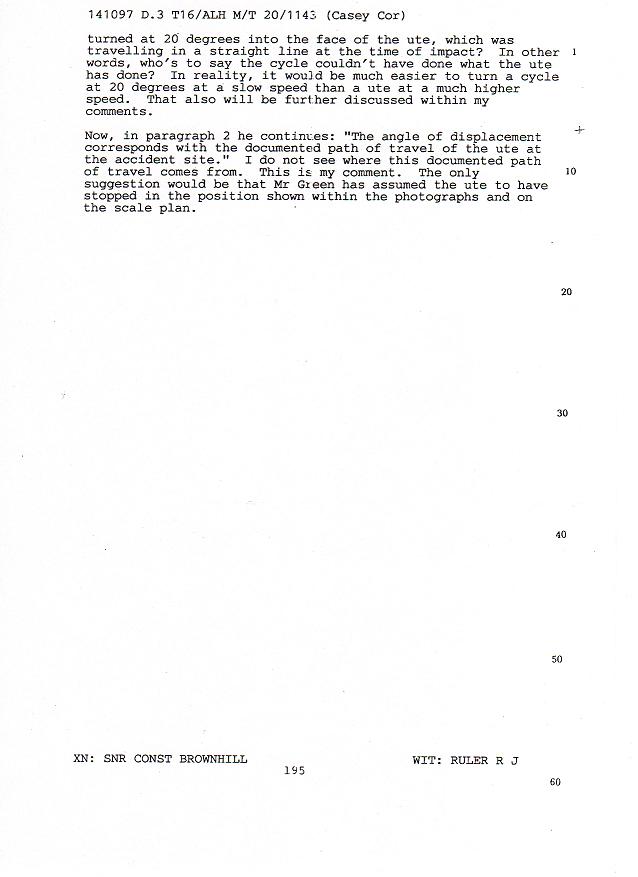
|
Img079 Transcript - 14 October 1997, page 196
Sergeant John Ruller refers to the utility being reversed as an explanation of the bicycle sticking out in front of the utility involved in the accident (Img009). With reference to the vehicle mounting the curb, Sergeant John Ruller states:- "As it mounts the kerbing on an angle, it is generally a very narrow type of mark that you can actually see the tread pattern on the shoulder of the tyre." Attention is drawn to view the Img010 and Img037 wherein it can be adduced that such a mark did exist on the left wheel of the utility as an indication that the vehicle did mount the curb. Please view Img002 for dark tire markings on the curb edge of the traffic island to the left.
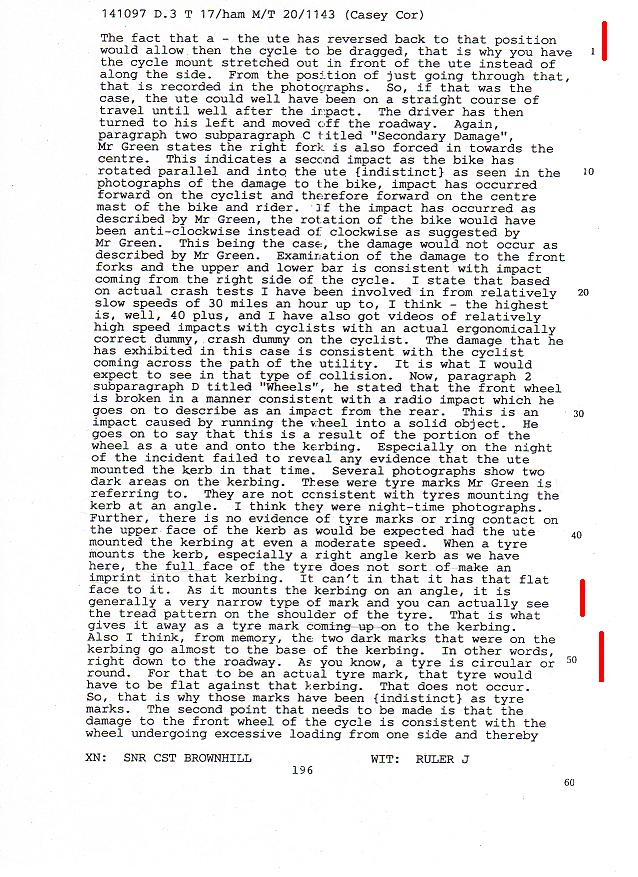
|
Img080 Transcript - 14 October 1997, page 197
Again no reconstruction of Andrew's accident. The evidence shows that the front bicycle wheel had wrapped around the left front tire of the vehicle involved in the collision. The forensic evidence concerning the brake marks show that the vehicle was travelling between 40 kilometers per hour and 50 kilometers per hour. Therefore, the driver of the vehicle travelling at that speed, would have had the ability to mount the curb. The evidence shows that this event did occur, i.e. the vehicle mounted the curb to hit Andrew.

|
Img081 Transcript - 14 October 1997, page 198
Note how obsessive Sergeant Robert John Ruller is about the vehicle traveling at 80 kilometers per hour instead of looking at the fact that the vehicle was going at 40 to 45 kilometers per hour and had the capacity to mount the curb, as did my son who had the capacity to cycle at 40 to 45 kilometers per hour to mount the curb in order to get away from Phillips. Sergeant John Ruller states that my son went into the left passenger door. There is no blood in the lower door panel. There is no bicycle front wheel imprint impact image damage plus handle bar imprint impact image damage into the vehicle's left passenger door. There is no accounting as to how the windscreen was damaged (Img015) by Sergeant Ruller. I had spoken to a forensic accident reconstruction expert. He told me that it often occurs that if a cyclist does go into the door, as suggested by Sergeant John Ruller, the cyclist usually catapults over the roof of the vehicle and lands on his feet, with little or no injury, i.e. gives himself a shake and walks off
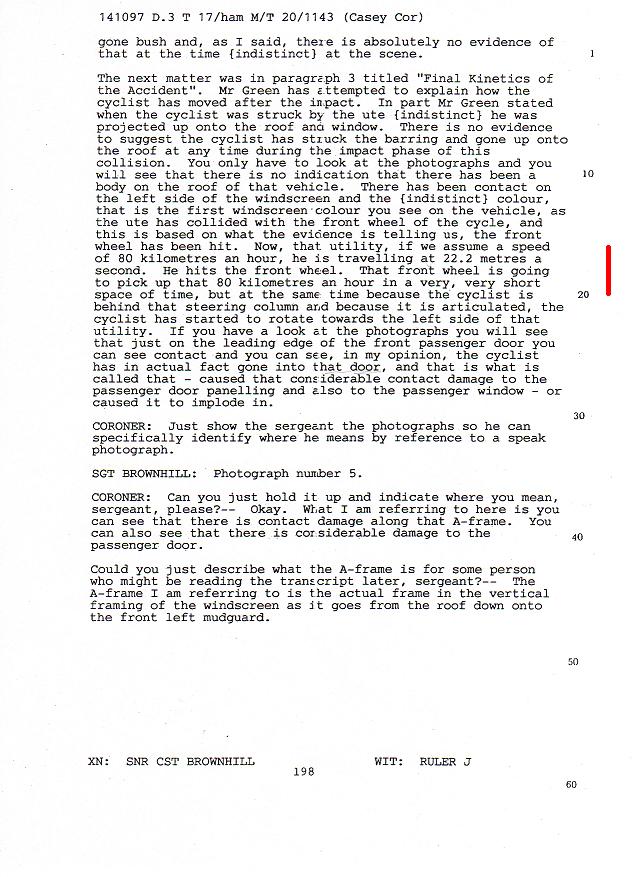
|
Img082 Transcript - 14 October 1997, page 199
The day following the accident, Sergeant Robert John Ruller photographed the path of travel of Andrew on the utility from the initial contact hit with the utility’s left side of the windscreen, as going along the left passenger door and into the back tray of the utility - Please refer to Img015, 016 & 017. After photographing this evidence, I do not understand why Sergeant Robert John Ruller would state that Andrew had rotated underneath the rear tray of the utility. This photographic evidence of Andrew’s path of travel as taken by Sergeant Sergeant Robert Ruller is consistent with what Constable Ben Dyball had told me on the night of the accident, and that is Andrew fell into the back tray of the utility. There was no evidence of any body tissue under the bottom tray of the utility. The photographic evidence that Sergeant John Ruller had taken shows scuff marks and other marks on the front mudguard - see Img013.

|
Img083 Transcript - 14 October 1997, page 200
Sergeant Robert John Ruller said that the scrape marks around the utility’s left wheel were caused by the bicycle being caught up and wrapped around while the vehicle was still traveling down the roadway (Img010); but there is no such corresponding contact damage to the road surface to verify Sergeant John Ruller's claims. Again Sergeant Robert John Ruller indirectly confirms that the utility had mounted the curb by leaving a very short sharp mark on the curb’s edge. Also note that Sergeant Robert John Ruller did not have his police note book with him. There is reference made by Sergeant Robert John Ruller to the bicycle being pulled out from underneath the utility and damaging the edge of the mudguard (Img009). When you view the image you will see the bottom edge of the mudguard that had been pulled out and blue paint from the bicycle on that portion of the damaged mudguard.

|
Img084 Transcript - 14 October 1997, page 201
Sergeant Robert John Ruller admits that the vehicle and the bicycle had been moved. He makes no determination as to where the vehicle and bicycle had been moved from. Sergeant Robert John Ruller makes no reference to the location of the debris of the accident to show the point of collision being on the grassed area of the traffic island. Sergeant Robert John Ruller ignores the fact that the evidence shows that the utility was traveling at 40 to 45 kilometers per hour and had mounted the curb to hit Andrew. For all of Ruller’s expertise, one can view Sergeant Robert John Ruller’s testimony with suspicion. The hard forensic evidence shows that the vehicle was travelling at 40 to 50 klms per hour and not at a high speed as Sergeant John Ruller suggests at 70 to 84 kilometers per hour
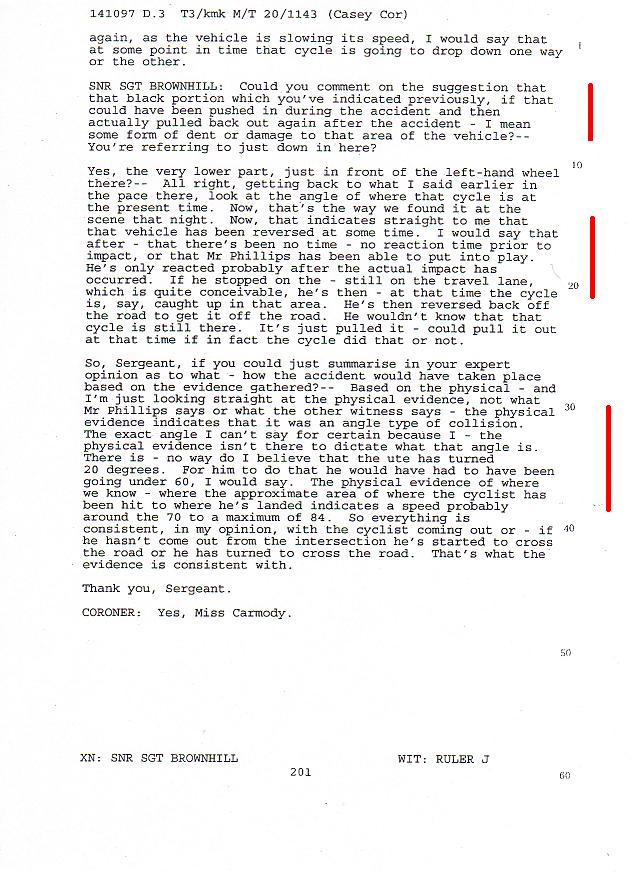
|
Img085 Transcript - 2nd December 1996, page 86
Scott Anthony Bryant had claimed that he was traveling behind John Phillips, the driver of the utility. Scott Anthony Bryant volunteers the information that he does not remember if John Phillips had stopped his vehicle and then taken off again; or seeing if the vehicle swerved or jumped. The question to ask is - "How did Scott Anthony Bryant know that the vehicle had stopped and had swerved or jumped?" The police got Scott Anthony Bryant’s statement two weeks before the hearing

|
Img086 Transcript - 2nd December 1996, page 87
Scott Anthony Bryant could not recall the vehicle he was driving. Records from the Queensland Transport Department show that Scott Anthony Bryant did not have any vehicles at the time of the accident, 12 January 1004. Records from the Queensland Transport Department show that Joseph Wills, 130 Macarthy Road, Marsden, owned the red Ford Falcon 045CEW that was traveling behind the utility. Scott Anthony Bryant and John Phillips, the driver of the utility, stayed at the accident site till 11.30pm. The question to ask is "What was he doing there till 11.30pm?"
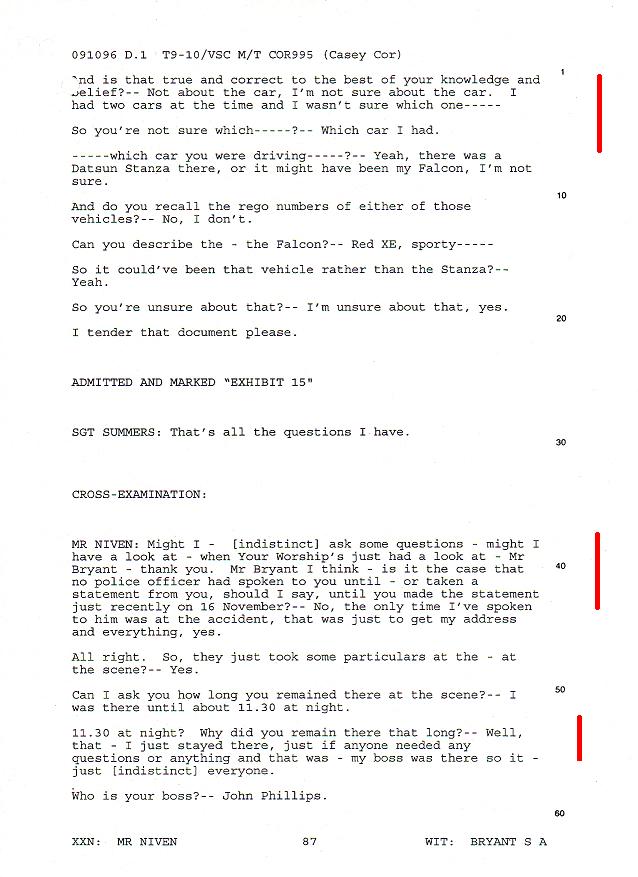
|
Img087 Transcript - 2nd December 1996, page 88
John Phillips and Scott Anthony Bryant had claimed that they had worked at the same construction site, i.e. the overpass on Port Road, at the Port of Brisbane
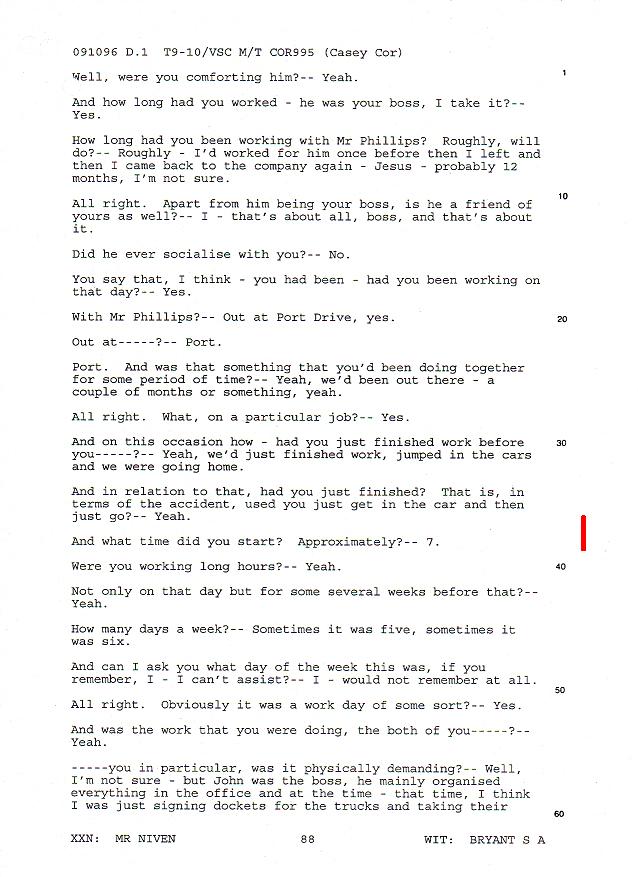
|
Img088 Transcript - 2nd December 1996, page 89
Scott Anthony Bryant stated that they started work at 7.00am; then after work was finished they had a chit chat and then drove home. The accident occurred at about 6.50pm. Sounds rather odd to have a chit chat after staring so early in the morning and then taking off as my nephew, Alexander Kirk, and my son, Andrew David Shea, cycled by. I am pretty sure that regulations prevent construction workers more than a specified amount of time per day - i.e. 7.00am start finish by 4.00pm. There was nothing produced to the Court to show that these persons had actually worked at the construction site as had been claimed
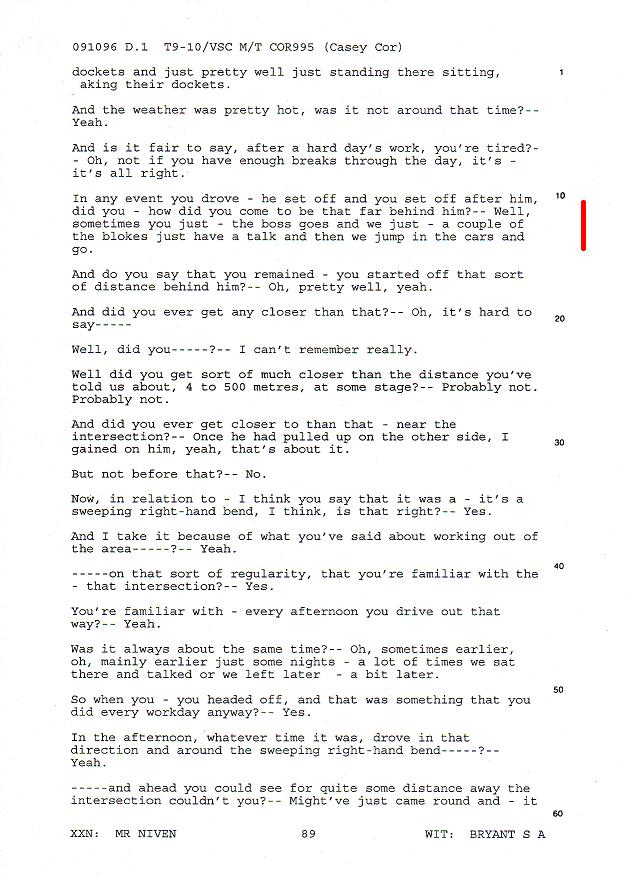
|
Img089 Transcript - 2nd December 1996, page 90
Scott Anthony Bryant volunteers the information that he did not recall if he seen John Phillips braking. Again Scott Anthony Bryant refers to the swerving of the vehicle. Mr Niven asked him if he saw a bit more than he is telling to the Court
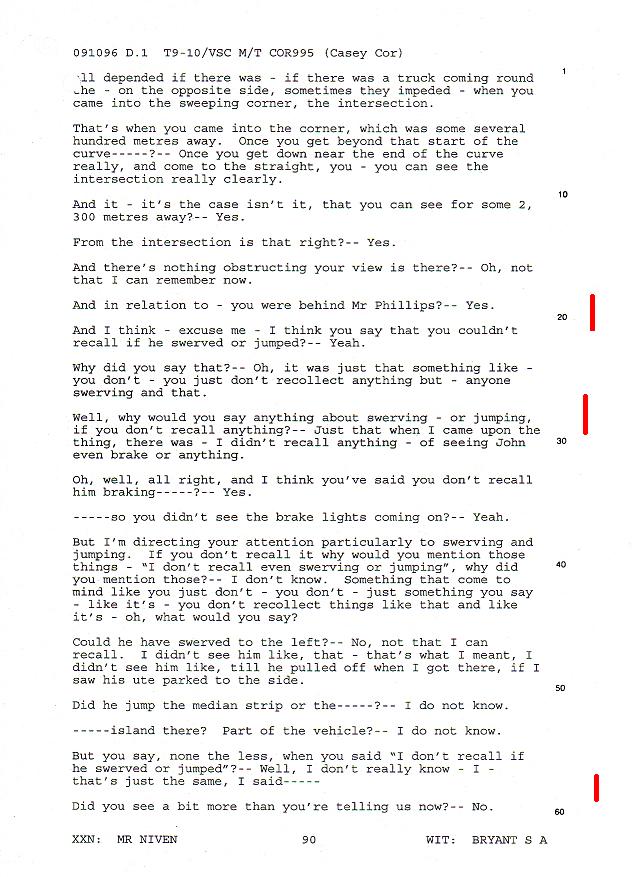
|
Img090 Transcript - 2nd December 1996, page 90(a)
Scott Anthony Bryant states that he did not recall seeing the collision. Scott Anthony Bryant states that he had been involved in a collision previously. I am of the opinion that it was Scott Anthony Bryant who was driving the utility and not John Phillips. John Phillips could not have drove 75 meters because the shattered glass had hit his face (Img052 & 053). Scott Anthony Bryant did not own a vehicle at the time of the accident. Joseph Wills owned the Red Ford Falcon that is parked in the photograph behind John Phillips’ utility (Img005)
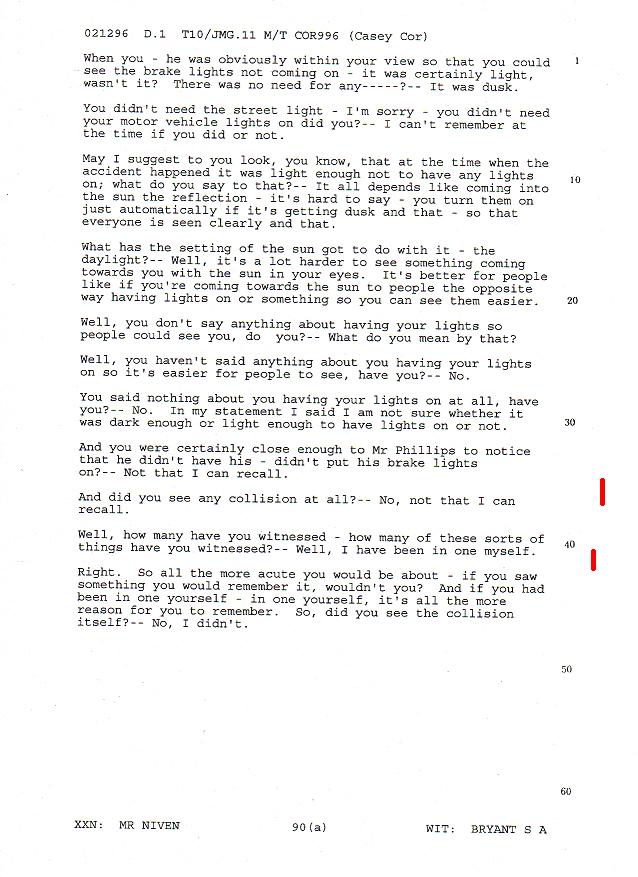
|
Go to top of page |
|